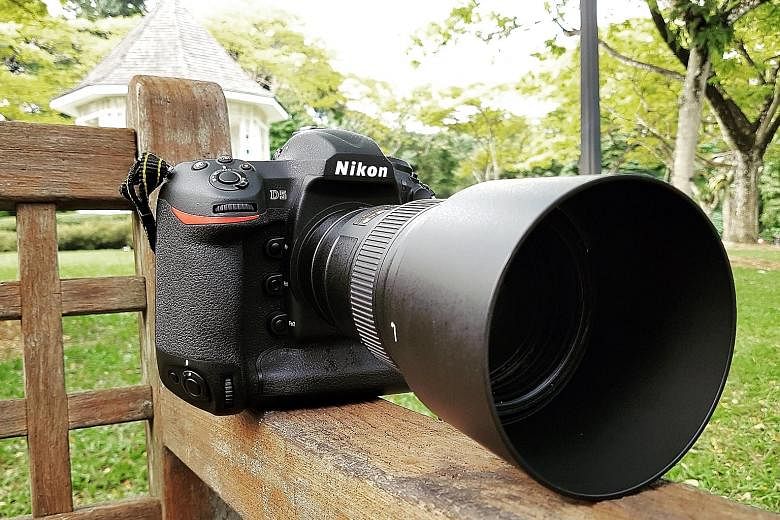With the Rio 2016 Olympics around the corner and more historic images waiting to be made, Nikon has released its flagship professional DSLR, the D5.
Improvements from the 2014 D4S include a new 20.8-megapixel full-frame image sensor (from 16.2-megapixel), an increase of autofocusing (AF) points to 153 (from 51 AF points), a 180,000-pixel metering sensor (from 91,000-pixel), and a 3.2-inch touchscreen display (the D4S has a non-touchscreen display).
In addition, the D5 has an upgraded Expeed 5 image processor with a maximum ISO setting of 3,280,000, a whopping increase from the maximum ISO of 409,600 in the D4S. Shooting speed has also increased to 12 frames per second (fps), from D4S' 11fps. The D5 is now able to shoot 4K videos, which the D4S is unable to do.
With an eye on Nikon D4 and D4S upgraders, the D5 retains most of the looks, controls and button layout of its predecessors.
The D5 is built like a rock, with a weather-sealed, magnesium-alloy body. Its generous and ergonomic rubberised horizontal and vertical grips allow you to hold it firmly and comfortably in either orientation.
The myriad of buttons and dials might confuse beginners, but they are a heaven-sent for professionals.

As with its predecessors, changing shooting modes requires you to hold down the Mode button - now sited on the top left - with your index finger and adjust the right rear dial with your thumb.
There are also controls to facilitate shooting in portrait and landscape modes, including two front dials, two rear dials, two mini-joysticks for AF point control, and two AF-On buttons.
The only new physical addition is the extra function button sited on the right of the lens mount, below two other function buttons. These three buttons can be customised to control various settings, such as to enable the viewing of photo shooting information.
-
TECH SPECS
PRICE: $8,639 (body only)
SENSOR: 20.8-megapixel full-frame CMOS
DISPLAY: Fixed 3.2-inch touchscreen LCD with 2,359,000 dots; optical viewfinder
SENSITIVITY: ISO 100 to 3,280,000
SHOOTING SPEED: Up to 12 frames per second
WEIGHT: 1.4kg (body only, with battery and memory card)
RATING
FEATURES: 4/5
DESIGN: 4/5
PERFORMANCE: 5/5
BATTERY LIFE: 5/5
VALUE FOR MONEY: 4/5
OVERALL: 4/5
Handling is amazingly intuitive. Any professional photographer should be able to master its controls quickly.
Like the D4S, the D5 has dual memory card slots (for CF and XQD cards), which make simultaneous back-up possible. You can store more images with the two memory cards, or save RAW images on one card and JPEG images on the other.
The D5 is super quick. The camera starts up instantly, so you will not miss any decisive moments. Shutting down takes around 1sec. Shutter lag is non-existent.
Using a 32GB CF card with a writing speed of 160MB per second, the D5 was able to shoot 83 RAW images in 8.2sec before the buffer ran out. This is just magnificent, considering that the D4S managed to capture only 60 RAW images in 8.5sec when I reviewed it two years ago.
To test the camera, I took it and a Nikon 300m f/4E PF ED VR lens to the Botanic Gardens.
The D5's AF in bright sunlight is immediate and accurate. It was a cinch capturing well-focused shots of the kingfishers and hornbills in their speedy flights. I wouldn't have achieved such sharp focus with another camera.
In dim lighting conditions and using the Nikon 24-85mm f/3.5-4.5 lens, the D5 took only around 1sec to lock onto a focus, without the help of the AF assist light.
Image quality is spectacular, with sharp pixel rendition, vivid colours, natural skin tones and amazingly sharp details. You can really see the fine feathers of the birds.
Image noise performance is on a par with its predecessor. The images I shot look clean and noiseless until ISO 6,400. And I can hardly see any image noise even at ISO 12,800. Only at ISO 25,600 is there a slight loss of details with evident chromatic noise artefacts. I would not recommend using ISO 51,200 or above, as the loss of details is quite visible.
Battery life is superb - around 3,800 still images per full charge. I practically went a week of shooting without recharging the battery.
•Verdict: It might stun you with its hefty price tag. But the Nikon D5 is well worth the investment with its all-rounded performance in terms of handling, shooting speed and image quality. Definitely the choice of a professional.


